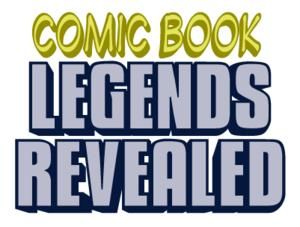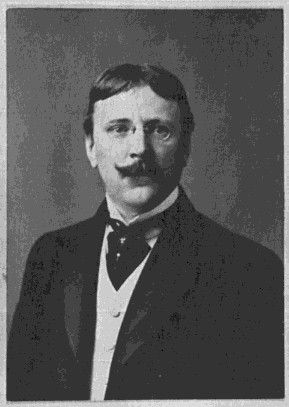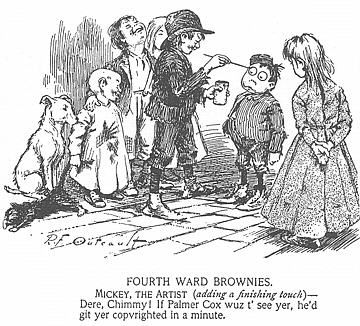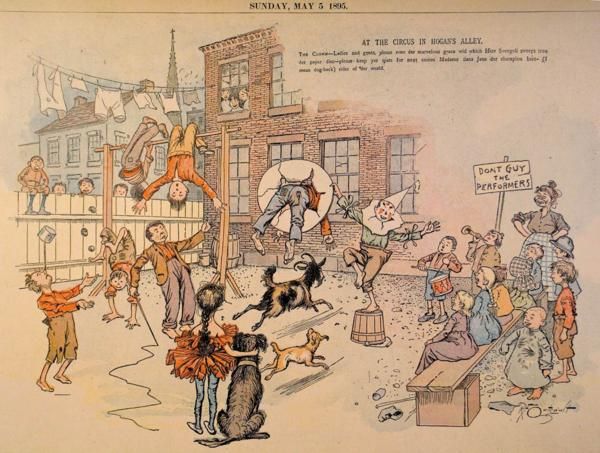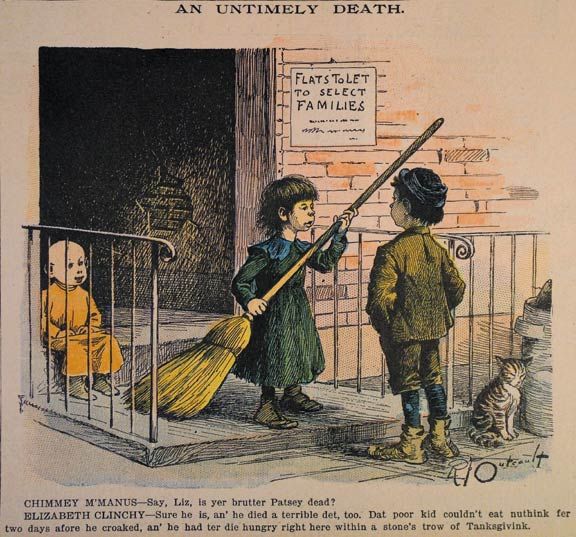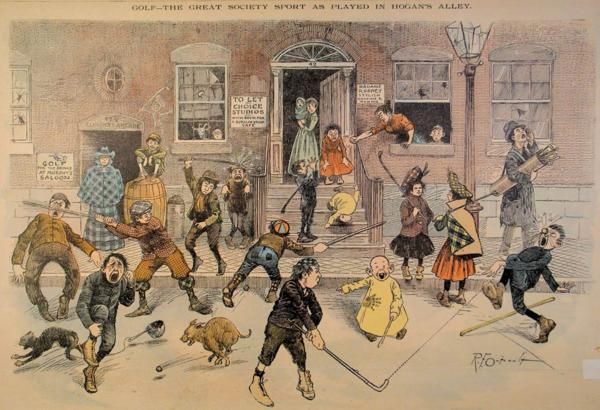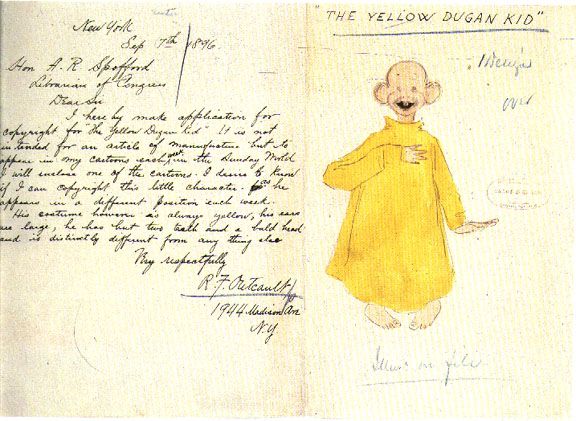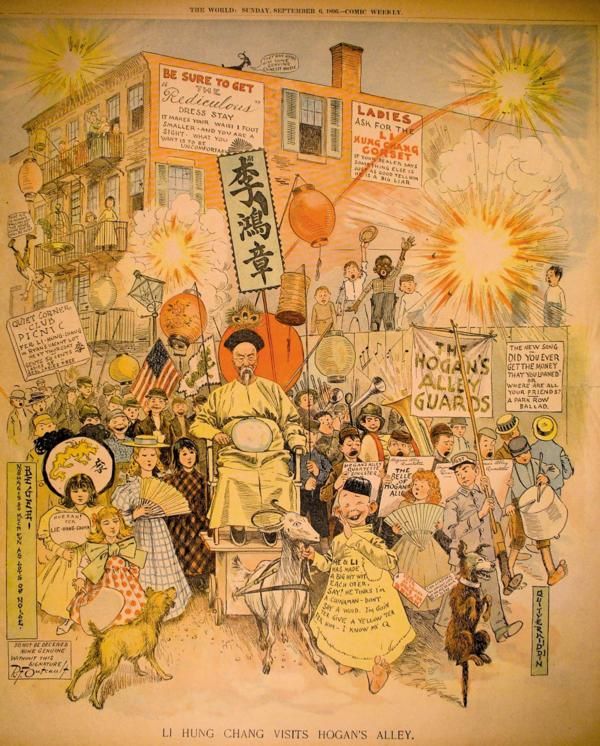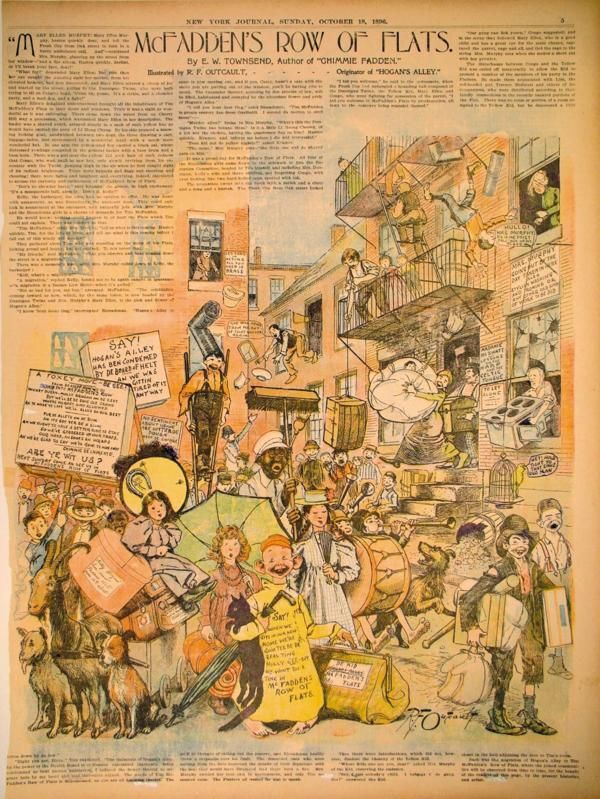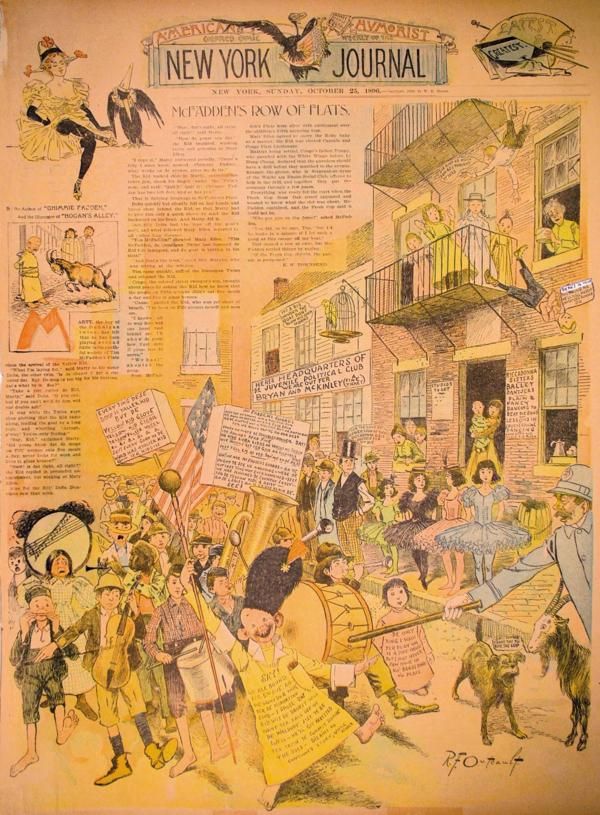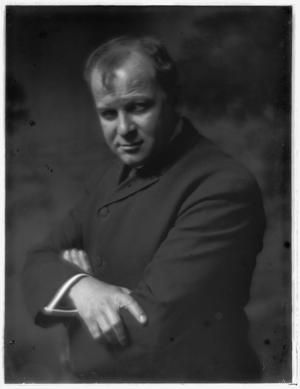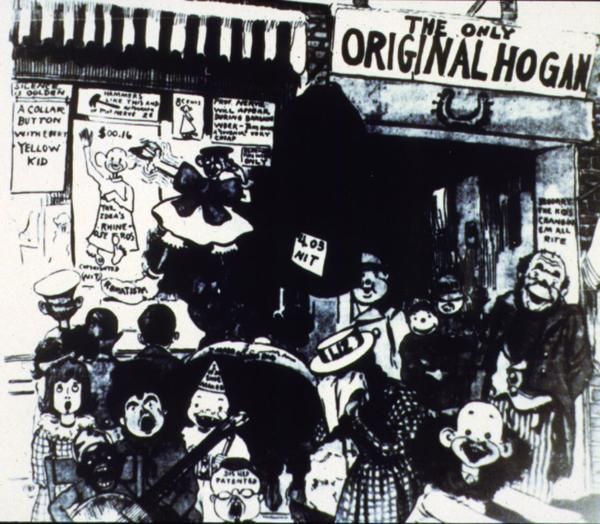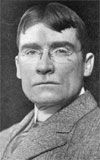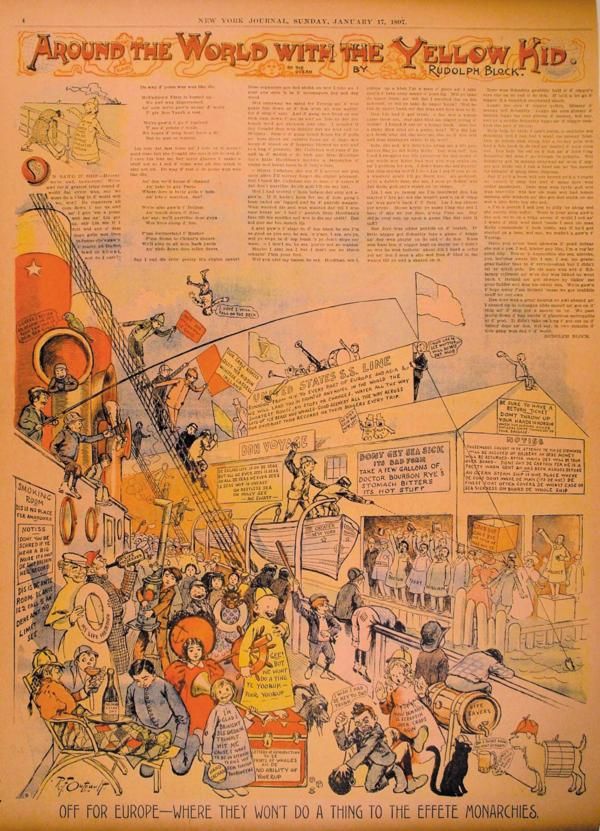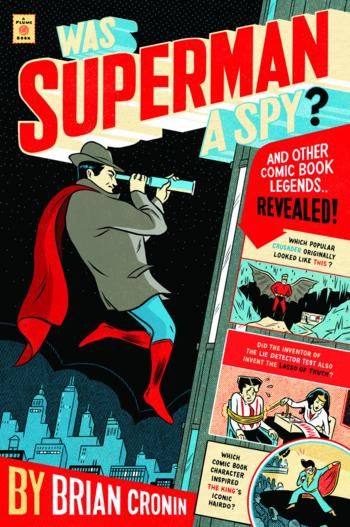Welcome to the two-hundred and ninth in a series of examinations of comic book legends and whether they are true or false. Click here for an archive of the previous two hundred and eight.
Comic Book Legends Revealed is now part of the larger Legends Revealed series, where I look into legends about the worlds of entertainment and sports, which you can check out here, at legendsrevealed.com.
This week, we're going to have another theme week - this time around, it's all legends involving perhaps the very first comic character ever, the Yellow Kid!
Let's begin!
COMIC LEGEND: The Yellow Kid's famous yellow shirt came from an experiment in yellow ink.
STATUS: I'm Going With True
Richard Felton "R.F." Outcault was born in 1863.
His early professional career was spent working with Thomas Edison as the technical artist for Edison's traveling shows of the late 1880s that went from town to town demonstrating the utility of Edison's many inventions (but primarily his electrical lights).
After a few years of this, Outcault turned to cartooning in the pages of all the various major New York cartoon magazines of the day, like Judge and Truth.
It was actually in the pages of Truth magazine, not the New York World newspaper, that the Hogan's Alley first appeared.
Here he is in a cartoon in Truth from June 2, 1894...
(Feudal Pride in Hogan's Alley
Little Rosilla McGraw -- No; we won't come and play with you, Delia Costigan. Our rejuced means may temporary necessitate our residin' in a rear tenement, but we're jist as exclusive as when we lived on the first floor front and papa had charge of the pound in the Department of Canine Captivity! )
That's a pretty awesome little cartoon there. As you can tell, it was clearly meant for an adult audience.
After a few more Hogan's Alley cartoons featuring the Hogan's Alley kids over the rest of 1894 and the beginning of 1895 (it was not yet a recurring feature, really, as it was about five cartoons spread out over a year's worth of magazines), Outcault's finally had one of his Truth cartoons reprinted in the New York World (which was owned and run by Joseph Pulitzer) on February 9, 1895, the first newspaper appearance of the Yellow Kid (and the first clear appearance of Mickey Dugan, who would become the Yellow Kid soon enough).
(Fourth Ward Brownies
Mickey, The Artist (adding a finishing touch) -- Dere, Chimmy! If Palmer Cox wuz t' see yer, he'd git yer copyrighted in a minute. )
Outcault was already beginning to get some work in the pages of The World, but really, it was not until they reprinted his Hogan's Alley cartoon that the work became steady.
As you can see, the Yellow Kid was not yet a major part of the strip. He was just one of the various denizens of Hogan's Alley.
The strips were initially in black and white, but Hogan's Alley proved popular enough that by May of 1895, they were in full-page color drawings (click on all of the full-page drawings to enlarge them).
As you can see, the Yellow Kid is not even Yellow in these early cartoons.
Finally, in November of 1895, the Yellow Kid actually matched his name...
And the yellow that made up his outfit is part of a longstanding myth.
First off, for years, the story went that the Yellow Kid's outfit was the FIRST usage of the color yellow in newspapers. That's obviously false, heck, you can see some of these earlier cartoons even had yellow in them!
So if that's what you're going with "The Yellow Kid's outfit was colored yellow because they wanted to test out the color yellow on SOMEthing," which WAS an accepted story for years, then no, that's incorrect.
However, I don't think that was ever REALLY the story, but rather, I think that was a misinterpretation of the REAL story, which is that the Yellow Kid was colored yellow with an experiment IN yellow inking rather than the FIRST use of yellow ink.
It is know that at the time (1895), yellow ink did not dry as well as the other colors. You'll notice that yellow, while used, WAS used less than the other colors.
Therefore, the story goes that the Yellow Kid was colored yellow (as opposed to his earlier blue) with an experimental new TYPE of yellow ink through the development of different types of chemical inks, which often involved various types of tallow (which is made up of animal fat).
THIS, to me, sounds believable.
First off, we know that new chemical inks were being invented during this time (by invented, I really mean "being mixed and matched to see what would work").
Secondly, in his 1916 book, Training for the Newspaper Trades, Don Carlos Seitz (business manager for the New York World) repeats the "trying out a new type of yellow ink" story.
He says (thanks to Glen Cadigan for the quote):
“The ” yellow ” phase developed when William J. Kelly, the pressman, whose knowledge of color printing had been obtained printing specimen books for George Mather’s Sons, the ink Makers, complained that he could get no results from the wishy-washy tints turned out by the art department and begged for some solid colors. About this time R. F. Outcault, a clever youth from Sandusky, Ohio, who had recently invaded New York, turned in to the Sunday editor, then Arthur Brisbane, several black and white drawings, depicting child-life in a tenement district called ” Hogan’s Alley.” I carried Kelly’s kick to C. W. Saalburg, the colorist who was painting the key plate of the “Alley,” and being of quick understanding said: ” All right, I’ll make that kid’s dress solid yellow!” ,Suiting the action to the word he dipped his brush in yellow pigment and ” washed ” the ” kid.” For once Kelly was right. The ” solid color ” stood out above all the colors in the comic. The ” yellow kid ” arrived. The success of the series led to the capture of Mr. Outcault by the rival Journal newly revived by William R. Hearst, and to a fortune for the artist. The rivalry resulting, for the World’s ” kid ” was long continued by George B. Luks, since a notable American painter, and stamped ” yellow ” on an enterprise that is now common to all news-papers.”
So yeah, when Seitz says the "solid color," he's basically just referring to experimenting with different types of ink meant to wash better and therefore look brighter.
Thirdly, many different other books have also told the whole "trying out a new type of yellow ink" story, although few have been as detailed as the Seitz book, so I'm less inclined to give them THAT much validity.
It is clear that once the Kid WAS colored yellow, he definitely stood out in the cartoons, and soon he became the most popular character in the strip, and also, the strip became more and more juvenile and FUN, and rather than being a strip intended for adults, it seemed to be becoming a strip meant for EVERYbody. Check out this bit about the Hogan's Alley gang discovering golf...
Funny stuff.
So anyhow, do I believe the "new type of ink" story? I'm thinking yes.
COMIC LEGEND: When Outcault left The World with the Yellow Kid, a lawsuit ensued with the result being that The World got to produce their own Yellow Kid cartoons while Outcault did his own for the Journal.
STATUS: Slightly False
In 1895, William Randolph Hearst, inspired by the success of the New York World (whose circulation had risen from the low five figures into nearing a million copies sold), purchased the New York Journal. And almost immediately, he began ransacking Pulitzer's employees.
In the Fall of 1896, it was time for him to come calling for perhaps Pulitzer's most prized employee, Outcault.
In the time leading up (and perhaps Hearst had made overtures earlier on, or perhaps Outcault just sensed that it was coming) to this move, Outcault began seeking legal protections for his famous character, the Yellow Kid. By the this time, billboards were already popping up featuring the Kid and it was clear that the Kid was worth a lot of money.
On September 7th, Outcault applied for a copyright on the Yellow Kid.
On his strip on the 6th of September, Outcault also added a line saying:
"Do Not Be Deceived None Genuine Without This Signature"
over his signature.
Here's the line:
However, the Treasury Department (who handled copyright claims at the time) informed Outcault that he had failed to secure a copyright on the Kid.
In any event, Hearst ended up making Outcault a significant offer to leave the World for the Journal. Outcault went to Pulitzer with the offer. He more or less matched it, but Hearst bettered it, and Outcault finally determined he would work for Hearst.
Here is where things get a bit tricky.
As the story goes, Pulitzer then sues Outcault and Hearst saying they can't take Yellow Kid, and the court settles it by letting Outcault take the Yellow Kid, but allowing Pulitzer to do his own Yellow Kid comics (and use the name Hogan's Alley, as well).
That just does not appear to be true.
I have seen no record of any lawsuit ever filed in this case.
Almost certainly, what we had was that Pulitzer DID own the name "Hogan's Alley," so he was not going to stop using it, and since Outcault did not have a copyright on the Kid, there really was no protection available at the time. Hearst just wanted the NAME, he did not necessarily care about getting the Kid.
In any event, Outcault handled his new digs at the Journal in an amusing fashion, having Hogan's Alley condemned and having the Kid take us to the NEW home, McFadden Flats!
Pulitzer hired the talented painter George Luks to take over Hogan's Alley.
Luks soon retaliated, depicting Outcault as a greedy hack selling "souvenirs" of his "copyrighted" drawings...
Really, it truly appears that the only battle between these folks was a war of words, not a legal fight.
COMIC LEGEND: The Yellow Kid led to the term "Yellow Journalism."
STATUS: True, But Not In The Way Most People Think
For years, the term "yellow journalism" has been credited as being due to the rivalry between Hearst and Pulitzer over the Yellow Kid. You know, the idea that they were more concerned about a comic strip that would sell newspapers than they were over the actual news.
Reader Michael Heide suggested I do a piece on the term way back in October of 2006!
He said at the time:
>>A fierce newspaper rivalry in the 1890s between Joseph Pulitzer and William Randolph Hearst spurred the creation of the newspaper comic strips that proved extremely popular with newly arrived immigrants who were only semi-conversant in English. These newspaper strips became highly effective weapons in the circulation wars of the time, and the innovation of printing a comic strip in color (a radical move, even if it was only the single color yellow) catapulted Hearst’s papers ahead of his competitors. In fact, so closely associated would the Hearst papers become with Richard F. Outcault’s visually striking and popular comic strip The Yellow Kid that critics would denigrate all of Hearst’s sensationalistic newspapers with the sobriquet “Yellow Journalism.”<<
Had you heard that one before? That's where the term "Yellow Journalism" came from? Could this be something for an upcoming edition of Comic Book Urban Legends Revealed?
First off, in a funny coincidence, I just saw Michael commenting the other day on an entry at Movie Legends Revealed. So thanks for sticking with me for so many years, Michael!
Secondly, the above piece (which Michael saw in James Kakalios' "The Physics of Superheroes") is already wrong, as we noted above, since color was already used well before Hearst got involved in newspapers.
However, the piece DOES basically get across the main idea that people believe, that the term "Yellow Journalism" is derived from the fight over Yellow Kid.
That, though, is not the case.
Do note that people DID complain about this fight for the Kid between Hearst and Pulitzer. And people DID complain about the sensationalistic "being more concerned about selling papers than getting the news right" style of both Hearst and Pulitzer (mostly Hearst, of course). However, they just did not refer to it as "yellow journalism." The term used most frequently was "new journalism." This term "new journalism" is not to be confused with the way we think of "new journalism" today, which is using a literary fiction approach to non-fiction journalism, exempflied by the work of Tom Wolfe, Truman Capote, Hunter S. Thompson and Norman Mailer mostly during the 1960s and 1970s. The way critics used "new journalism" back then was in a derisive fashion, differentiating it from "good, old-fashioned journalism."
The man who coined the term "yellow journalism" was Elvin Hardman, an editor at the New York Press.
He used the term after he, too, had used "new journalism" to knock Hearst. He also used the term "nude journalism" before finally, in January of 1897, coming up with the term "yellow journalism."
And while it WAS, indeed, a reference to the Yellow Kid, it was actually a direct response to Heart's recent idea of using the Yellow Kid mixed into the Editorial Pages, where the Kid was on a trip around the world!
Hardman found the idea of mixing cartoons with real news highly offensive, and it was THIS that he used to knock Hearst, suggesting that mix of information and entertainment (if only there was a combination of those two words - something pithy) was not a good sign for the sanctity of newspaper journalism.
Hardman's term was quickly picked up by the other critics of Hearst and Pultizer, and so a term was born!
Thanks to W. Joseph Campbell's excellent book on the subject, Yellow Journalism: Puncturing the Myths, Defining the Legacies
, for giving us the definitive history of the term.
Thanks so much to Richard D. Olson and his brilliant R. F. Outcault Society's Yellow Kid Site for all the great information he provides for fans of the Yellow Kid!
Also, thanks to David Westbrook's excellent work on the business side of the Yellow Kid strips.
Thanks to Glen Cadigan for the quote from Seitz's book!
In addition, thanks to the San Francisco Academy of Comic Art Collection, The Ohio State Univeristy Cartoon Research Library for some of the great Yellow Kid drawings seen above!
Okay, that's it for this week!
Thanks to Brandon Hanvey for the Comic Book Legends Revealed logo!
Feel free (heck, I implore you!) to write in with your suggestions for future installments! My e-mail address is cronb01@aol.com.
As you likely know by now, a month ago today, April 28th, my book finally came out!
Here is the cover by artist Mickey Duzyj. I think he did a very nice job (click to enlarge)...
If you'd like to order it, you can use the following code if you'd like to send me a bit of a referral fee...
Was Superman a Spy?: And Other Comic Book Legends Revealed
See you next week!

